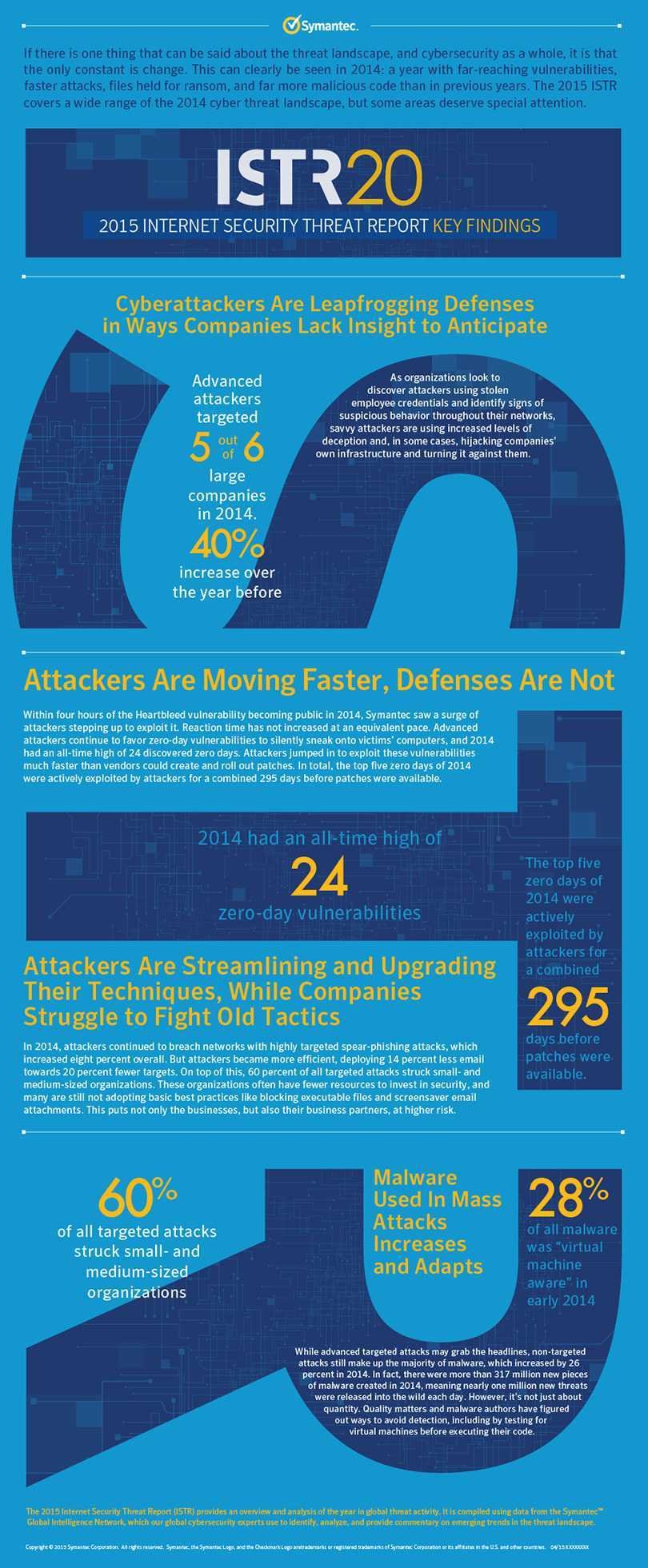In today's hyper-connected world, the question is no longer whether we will be attacked - but when. Her report Symantec, Internet Security Threat Report (ISTR), Volume 20, presents one change tactic in the behavior of cybercriminals: they infiltrate networks and evade detection by breaching the infrastructure of large organizations and using that infrastructure to their advantage. 
"Attackers do not need to break into a corporate network" knocking on the door "when the keys are already available for use," said Christos Ventouris, Southeast Europe Information Security Specialist. Symantec. "We see attackers cheating companies, as they manage to infect themselves with common Trojan-containing software upgrades, patiently waiting for their targets and downloading the file, which ultimately gives them unlimited access to the corporate network."
Attackers Achieve Speed and Accuracy
According to the Symantec report, it was a record year for zero-day vulnerabilities. The report also states that software companies took an average of 59 days to create and release patches - a big increase from the four days averaged in 2013. Attackers took advantage of this delay in the case of Heartbleed, too. exploited the vulnerability within four hours. There were a total of 24 zero-day vulnerabilities discovered in 2014, leaving the field open for attackers to exploit known security vulnerabilities before the respective patches were created, according to Symantec.
Meanwhile, the most advanced attackers continue to break into networks with high-level spear-phishing attacks, which increased by 8% in 2014. What is particularly interesting is the accuracy of these attacks, which used 20% less emails to penetrate successfully target organizations and integrate more drive-by malware downloads and other web-based exploits.
Additionally, Symantec remarked to the attackers:
- Use stolen email accounts from a victim-company to find new victims higher in the chain
- Take advantage of company management tools and procedures to move stolen intellectual property data within the corporate network before leaving it
- Create custom attack software within their victims' network to further cover their activities.
Digital Blackmail on Flowering
Email remains an important player in cybercrime attacks but continues to experiment with new methods of attacking portable devices and social networks to access more people with less effort.
“Cybercriminals are against base τεμπέληδες. Προτιμούν τα αυτοματοποιημένα εργαλεία και τη συμβολή των αδέξιων καταναλωτών να κάνουν την “δύσκολη” δουλειά” είπε ο κ. Χρήστος Βεντούρης, Information Security Specialist Νοτιοανατολικής Ευρώπης για τη Symantec. “Πέρσι, το 70% των περιστατικών απάτης που διενεργήθηκαν στα κοινωνικά δίκτυα διοχετεύθηκαν χειροκίνητα, καθώς οι επιτιθέμενοι εκμεταλλεύτηκαν την προθυμία των χρηστών να εμπιστεύονται περιεχόμενο που μοιράζουν οι φίλοι τους.”
While scams on social networks provide cyber criminals with easy money, some rely on more profitable and aggressive attack methods, such as ransomware, which had an increase of 113% last year. In particular, there were 45 times more victims of crypto-ransomware attacks than 2013. Instead of pretending to be law enforcement officials imposing fines on stolen content, as had been the case with traditional ransomware, the attackers changed their assault style by keeping records, photographs and other digital content of the victim in their possession, no longer covering their intentions.
Protect it, Do not Miss It!
Καθώς οι επιτιθέμενοι επιμένουν και εξελίσσονται, υπάρχουν ορισμένες tips που μπορούν να βοηθήσουν επιχειρήσεις και καταναλωτές να προστατευθούν με τον καλύτερο δυνατό τρόπο. Αρχικά, η Symantec προτείνει τις παρακάτω βέλτιστες πρακτικές:
For Business:
- Do not stay unprotected: Use sophisticated threats to help you find signs of exposure to threats and respond faster to relevant incidents.
- Make use of a strong approach to security: Implement a multi-level endpoint and network security protection that includes encryption, strong authentication and reputation-based technologies. Work with a company that provides managed security services to expand your company's IT team.
- Prepare for the worst: Incident management ensures that the security framework you have set is optimal, measurable and reliable and that any lessons from the past have strengthened the company's approach to security. Discuss the possibility of joining an external partner to your company's broadest potential to help with crisis management.
- Provide ongoing training to your executives: Establish guidelines and corporate practices and procedures to protect sensitive data found on personal and corporate devices. You regularly evaluate internally IT teams through practical exercises to ensure that they have the appropriate skills to fight cyber threats.
For consumers:
- Use strong passwords (passwords): This issue is constantly being emphasized. Using strong and unique passwords for your accounts and devices and updating them regularly - ideally every three months is the most effective solution. Never use the same password for multiple accounts.
- Be careful in social medium: Do not click on links from unknown and unexpected emails or messages on social media, especially if they come from unknown sources. Fraudsters know that the users they are more likely to click on links that come from friends, so they hack into these accounts to send malicious links to the account owner's contacts.
- Know what you share: When you install an online device, such as a home router or you download a new app, browse and find out what data that app is accessing. Disable remote access when not needed.






